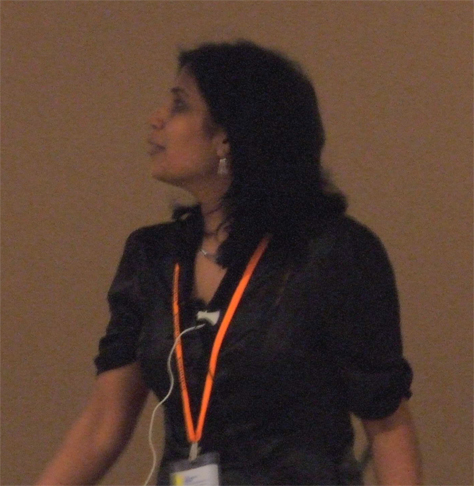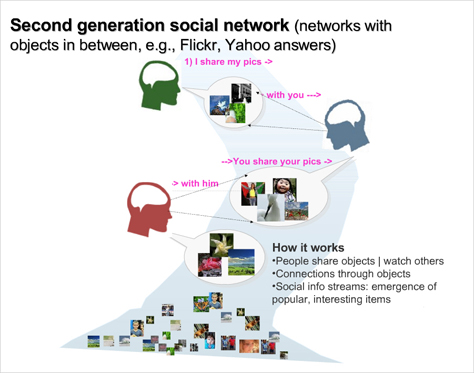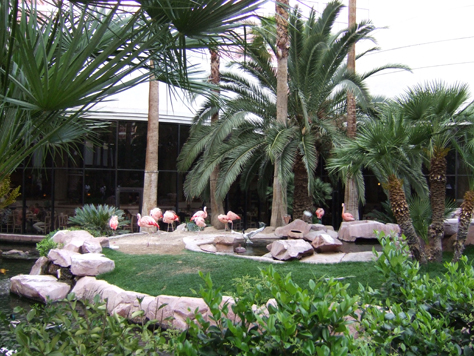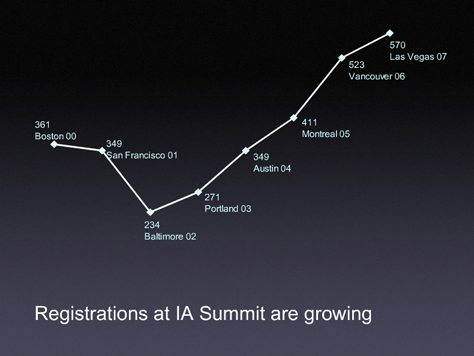Content and Presenters: Highlights
Day 2: Finding Innovation in the Five Hundred Pound Gorilla: Or Overcoming Fear, Building Trust, and Making Believers
Presenters: Kevin Cheng and Tom Wailes
According to Kevin Cheng (shown in Figure 11) and Tom Wailes (shown in Figure 12), finding innovation is not about “justifying design’s role in a project, how to be creative, or THE Innovation Process™.” Their talk described an innovation process that anyone can follow.
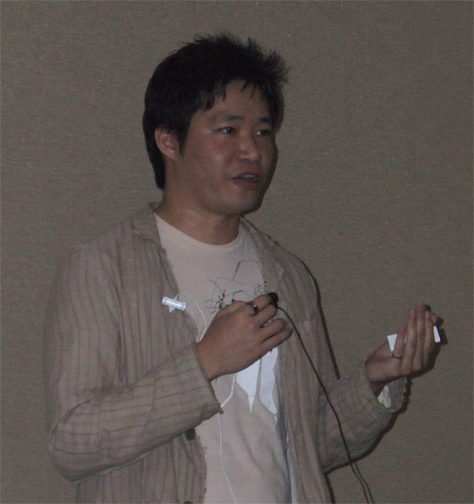
“Creativity is the act of producing new ideas, approaches, or actions, while innovation is the process of both generating and applying such creative ideas to convert them into novel, useful, and viable commercial products, services, and business practices.”—Wikipedia
“Creativity is not sufficient,” said Kevin. Making innovation happen requires “making time to innovate, overcoming fear, communicating ideas and process, building trust, and making believers.”
Innovation requires overcoming fear of “wasted time, high cost, diverted resources, failure, missed opportunities, and the unknown. You need a vision,” Kevin told us.
He suggested “starting small. Doing small things. Saying small things. Staying within your sphere of influence—people who will listen to you and agree with you. Convince someone enough that they’re an advocate for you. If you can’t find a single advocate within your sphere of influence, maybe you need to rethink. You could be wrong. Let others influence for you.”
In summary, Kevin told us, “Overcoming fear” requires that you “recognize the fears, say small things, do small things, let others influence for you, set expectations, and demonstrate success.”
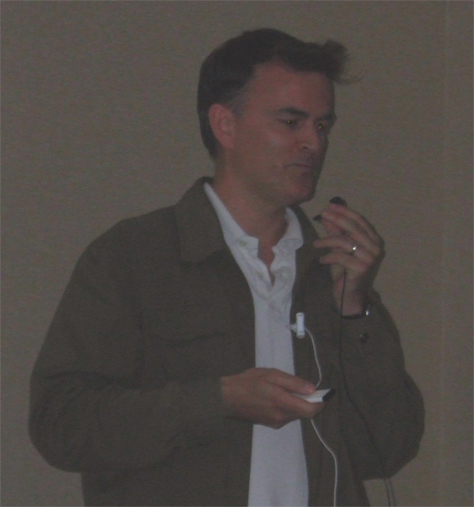
Tom Wailes spoke eloquently about building trust: “People trust you, because you show mutual respect. People don’t see everything behind the design,” as Figure 13 illustrates. “They haven’t seen how you came up with it. They don’t see why it will take so long. Make design deliverables communicate as clearly as possible to stakeholders. Involve the team cross-functionally. Keep stakeholders informed.”
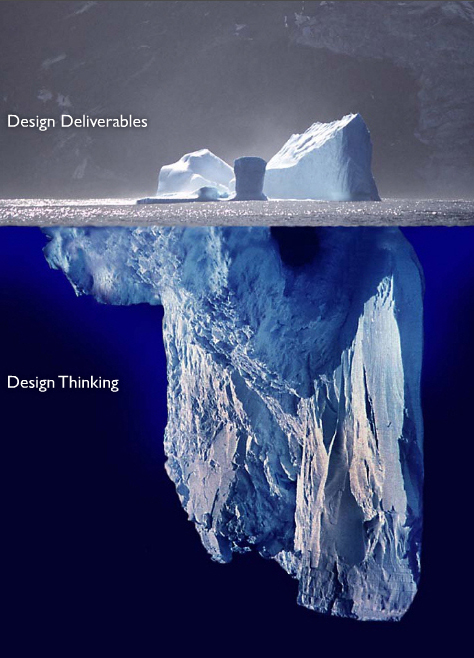
“A lot of the deliverables [designers] typically spend time on—wireframes and the rest—now, we don’t do that,” said Tom. We communicate design to the team through storyboarding, prototyping, product simulations. Wireframes are not very good at communicating product ideas or design thinking. We needed a clear goal.
“Sprints are not enough. Scrums aren’t great for ideating. Getting as many people involved, as many ideas as possible. Setting expectations. Not, at the end of the month, solving everybody’s problems. Visualize ideas in a really accessible format. Ideas can shine through. We’ve been playing around with different ways to visualize the experience,” as Figure 14 shows.
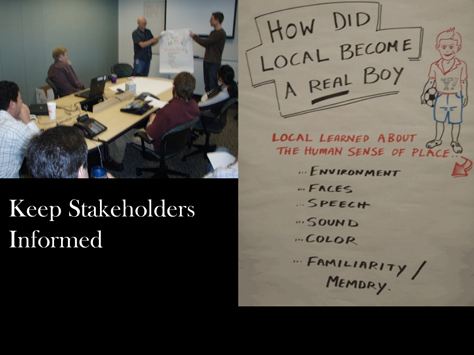
“Building trust” requires “mutual respect and honesty, a track record of delivery, transparency of process, and clear communication—‘show me’. In this business, you hear way too much of ‘They’re stupid.’ They’re not. They just think differently,” said Tom.
“Innovation must be novel, useful, and viable. … When we hear from the users, then we know we’re onto something. Once they believe, we can actually start doing stuff.”
Kevin and Tom’s presentation![]() is on SlideShare.
is on SlideShare.
Day 2: A Great Session I Missed: Architectures of Participation: What Communities of Practice Can Mean for IA
Presenter: Andrew Hinton
There was excellent buzz about Andrew Hinton’s session “Architectures of Participation.” I was sorry to miss this one, but it conflicted with Kevin Cheng and Tom Wailes’s session on innovation—one of the toughest choices I had to make. Andrew’s presentation![]() is available on his blog, Inkblurt.
is available on his blog, Inkblurt.
Day 3: A Great Session I Missed: Project Touchstones: How to Bridge Competing Viewpoints and Build Vision, Consensus, and Innovation
Presenter: Jess McMullin
Another session I missed and about which there was great buzz was Jess McMullin’s “Project Touchstones.” He spoke about an approach to improving project success. Jess’s presentation![]() is on SlideShare.
is on SlideShare.
Day 3: Communal Computing and Shared Spaces of Usage: A Study of Internet Cafes in Developing Contexts
Presenter: Jason Hobbs
Jason Hobbs presented the results of his study of Web usage in Internet cafes in Johannesburg, South Africa, for which he received a grant from the Information Architecture Institute. In such developing contexts, Internet cafes “are the primary means of Internet connection for many people.” Many people use these cafes for business purposes on a regular basis. They don’t have a private desktop, but instead carry their data with them on flash memory disks. Jason did an excellent job of communicating how vital a role Internet cafes play in these people’s lives.
Day 3: Startup Case Studies: How Five of Us Started Our Own Businesses
Presenters: Victor Lombardi, Frank Ramirez, Lou Rosenfeld, Gene Smith, and Christina Wodtke
Many designers are venturing into entrepreneurship in one way or another. Five designers told us briefly about their startup experiences.
Frank Ramirez gave a great talk on his startup, My Picturebook. He designed the Web site and created storyboards of the picture book, leveraging his “comic book roots,” then hired a company in India to develop it for him.
Victor Lombardi has opened Smart Experience, a new media school that offers Internet, mobile, and software classes for the continuing education of UX professionals. He said, “The Internet industry has grown so fast, it’s hard to keep up.”
Christina Wodtke’s Cucina Media developed PublicSquare, a content-management system for online publications. She spoke about five lies that keep designers from following their startup dreams:
- “I don’t know anything about business. I'm a designer.”—“Some people know more; others, less. Being an entrepreneur is one of the most humbling things you’ll ever do in your life. You can’t do everything or design as you want. You must launch and make a profit.”
- “Finally, a chance to do things right.”—“To learn, you have to do things wrong.”
- “I can do it like 37signals. We should all feel empowered like that.”—“Don’t believe the hype. Don’t take any one entrepreneur as your guide.”
- “VCs are evil.”—“They’re not evil. They’re capitalists. Venture capitalists have a job to do, which is to get 10x returns on their investments. If you take their money, you’re kind of agreeing to follow the path.”
- “I can’t do it alone.”—“Being an entrepreneur is mind-bogglingly lonely. On the other hand, VCs only care about the team, so you have to have business partners.”
Gene Smith spoke about his UX consultancy, nForm. And Lou Rosenfeld (shown in Figure 15) told us about Rosenfeld Media, his new book publishing company, which specializes in short, practical books about UX topics. He said, “You’re always at risk of becoming commodified. A lot of us have an entrepreneurial bent. We always want to be at the cutting edge. Your personal network is never a commodity, though your job skills may be. To figure out a business when you can look at problems in a unique way is design thinking. People would be happy to give you information if you ask them. Use your network.”
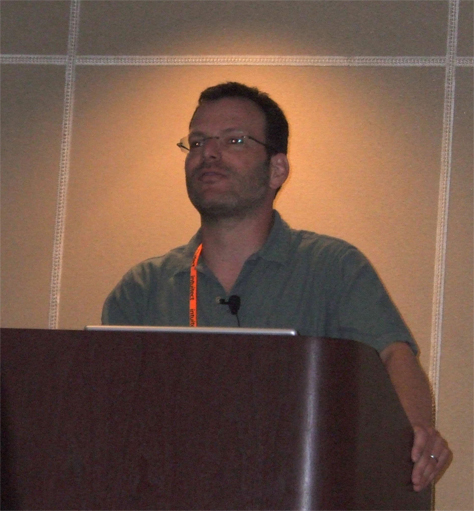
Here are some choice quotations from their freewheeling discussion:
- “You need to articulate these ideas in order to understand them.”—Lou Rosenfeld
- “Stealth deprives you of a lot of good advice. I’m anti-stealth.”—Christina Wodtke
- “I’d rather develop the next features than do patents.”—Frank Ramirez
- “I highly recommend Guy Kawasaki’s The Art of the Start.”—Christina Wodtke
- “One really important thing is not to hire people like you.”—Lou Rosenfeld
- A good startup idea is at “the intersection between your talent, your passion, and a need in the marketplace.”—Frank Ramirez
- “One thing that helps: Say publicly you’re going to do something.”—Lou Rosenfeld
This fascinating session provided a great lead-in to Rashmi Sinha’s closing plenary.
